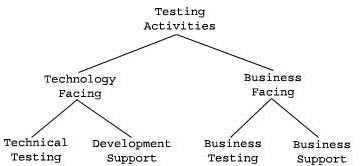An area of Agile Development where testers are usually absent is in Test-Driven Development and other developer testing activities. Since I like to collaborate with developers as much as I can, I asked them what other areas I could support them in. (Brian Marick calls these types of activities Technology-facing programmer support.) They told me that an area they would like to see testers work with them was in unit test development, especially when using Test-Driven Development. While I have pair tested with developers to help generate unit testing ideas, I haven’t actually worked with them during development in a pair programming kind of role. They felt that pairing with a tester would help them generate test ideas, and that it would be a good fit. The developer is thinking about programming most of the time while the tester is thinking about tests most of the time. I encourage developers to use test-infected development techniques, so I decided to stop theorizing and actually give it a try. I can’t very well answer the question about how a tester can add value to Test-Driven Development unless I’ve tried it.
Yesterday I paired with a senior developer who was developing an application in Java using the Intellij IDEA IDE which has JUnit integration. He kindly agreed to take me through the paces, but I have to admit I was a bit nervous. While I have basic Java programming skills, I am not a great coder and I usually work with scripting languages when I develop automated test cases. I wasn’t sure if I would be able to add any value to a programming activity or not.
After we walked through the business problem the coding effort for the day was to address, and some of the code that was in place, we began looking at the test framework. In this case, the developer had already written the first test, and an implementation that worked well enough to get that test to pass. We picked up at this point, and looked at the business rules and designed a new test. When we ran JUnit, the test failed, so that told us that the code implementation needed some work. The developer added some more logic to get that test to pass, and then we added another test case. We continued on adding a test cases which would initially fail, and the developer would work on the implementation to get the test cases to pass. At a certain point, he felt that we had a good basic set of test cases that covered enough of the business logic.
At the end of our session, we had an implementation that satisfied some basic test cases. I suggested test ideas, but was completely dependent on the developer to write the JUnit tests. I was absorbed in thoughts around more test ideas and what would seem feasible. I suggested a lot of test ideas that we could tackle the next day, and we discussed what tests we could justify doing. My intitial response was to test as much as possible, while the developer was thinking about the big picture and what time we could spend on testing. I realized this would be a trade-off; testing everything as robustly as possible would cause a lot of duplicated effort.
I didn’t feel like I added a lot of value to this session. Granted, I was getting trained in how Test – Driven Development works. I caught some minor syntax errors as we paired; the developer caught a few in his own work as well. We both missed some coding errors, but the compiler and the unit tests caught those.
My thoughts at the end of the day were that I had learned a lot, but added little value. Clearly, I need to learn more about the process and do this more in the hopes of adding value to a developer. The basic test ideas that I had generated were already ideas that the developer had thought of. I then started to think of more complex test ideas, and felt that we had very little coverage. The developer agreed that the coverage was light and we needed to work on more tests the next day. I left at the end of the day thinking about further tests we could write – I could add value there.
